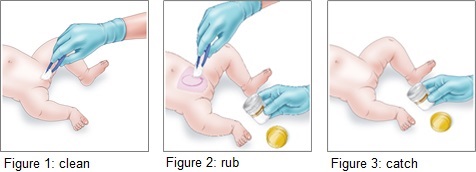Urine samples need to be collected for urine tests. Urine tests may be done for a number of reasons, and they are the only way to know for sure if your child has a urinary tract infection (UTI).
If the reason for the urine test is to determine if your child has a UTI, it is very important that the urine is obtained from your child in a sterile (clean) way so that the sample is not contaminated with bacteria (germs) from the skin.
Your doctor will tell you which method is most appropriate, and will provide you with any equipment you need to collect a sample.
Collecting a urine sample from younger children
Babies and small children can't wee ‘on demand’, which makes it difficult to get a sample. There are four possible ways to get urine from younger children.
Clean-catch
This method involves trying to catch some urine in a sample container that your doctor will give you. Start by offering your child a drink (cup, bottle, breastfeed). Most children who are going to wee for a clean-catch will do so within one hour.
- Have the sample container ready.
- Remove your child’s nappy.
- Wash your hands thoroughly before collecting the sample, or wear gloves.
- Clean the skin around the genital area. Use clean plastic tweezers and gauze soaked in water if available, or use baby wipes (Figure 1).
- Keep watching until your child does a wee. Be ready to catch a urine sample in the container when the wee comes.
- To encourage your child to wee, you can gently rub their lower abdomen (tummy) for a few minutes using a clean piece of gauze soaked in cold water (Figure 2).
- Hold the container away from your child’s skin when catching the urine (Figure 3). This is important so that bacteria from your child’s skin (or your skin) don’t contaminate the urine sample.

Bag specimen
Your doctor might give you a special bag to catch the wee in. This bag is stuck to the skin using gentle double-sided tape. In general, this method should not be used when testing for UTIs, as germs from the skin often contaminate the bag and urine.
Catheter
A catheter is a tube that a nurse or doctor puts into your child’s bladder through their urethra (the hole where the urine comes out). Fewer germs from the skin get into the sample this way compared with the clean-catch method. A catheter is a good way to collect a urine sample when
there is not much urine in the bladder. However, your child may find the catheter uncomfortable, and they may be distressed at being held still while it is being inserted.
Suprapubic aspirate (SPA)
For an SPA, your child will need to lie on their back and be held still. A doctor puts a needle through the skin of the lower abdomen into your child’s bladder and takes out some urine. Germs from the skin can't get into the urine, so SPA is the cleanest way to collect a sample.
An SPA is very safe, and problems are rare. SPAs are usually very quick, but because they involve using a needle, they can hurt and so they are only done in certain circumstances.
If your baby or child's bladder is not full, the doctor may not be able to get any urine with an SPA. In this case, the doctor may wait a little while and try again, or use the catheter method instead.
Collecting a urine sample from older children
You can collect a midstream specimen from older children who can wee when asked to. You doctor will provide you with a sample container.
- Clean the skin around the genital area, using gauze if available, otherwise with baby wipes, damp tissues or a clean, wet facewasher.
- When your child starts to wee, let some wee pass into the toilet.
- Collect a sample from halfway through the wee (midstream).
- Don’t let the sample container touch the skin.
Key points to remember
- If a urine test is for UTI, it is important that a urine sample is obtained in a sterile way.
- Clean-catch, catheters or suprapubic aspirates are suitable ways to collect urine samples from babies and small children for UTI tests.
- Midstream specimens can be collected from older children who can wee on demand.
For more information
Common questions our doctors are asked
What happens if my child’s midstream specimen ends up being
from the end of the wee?
If the specimen is from the end of the wee that is okay –
the important thing is not to catch the beginning of the wee, which is more
likely to be contaminated.
How painful is an SPA?
An SPA hurts about as much as a blood test. Occasionally, a numbing cream
is used on the skin before the SPA to reduce your child's discomfort, but it
will take 45 minutes to work.
Developed by The Royal Children's Hospital General Medicine and Emergency departments. We acknowledge the input of RCH consumers and carers.
Reviewed March
2018.
This information is awaiting routine review. Please always seek the most recent advice from a registered and practising clinician.
Kids Health Info is supported by The Royal Children’s Hospital Foundation. To donate, visit
www.rchfoundation.org.au.